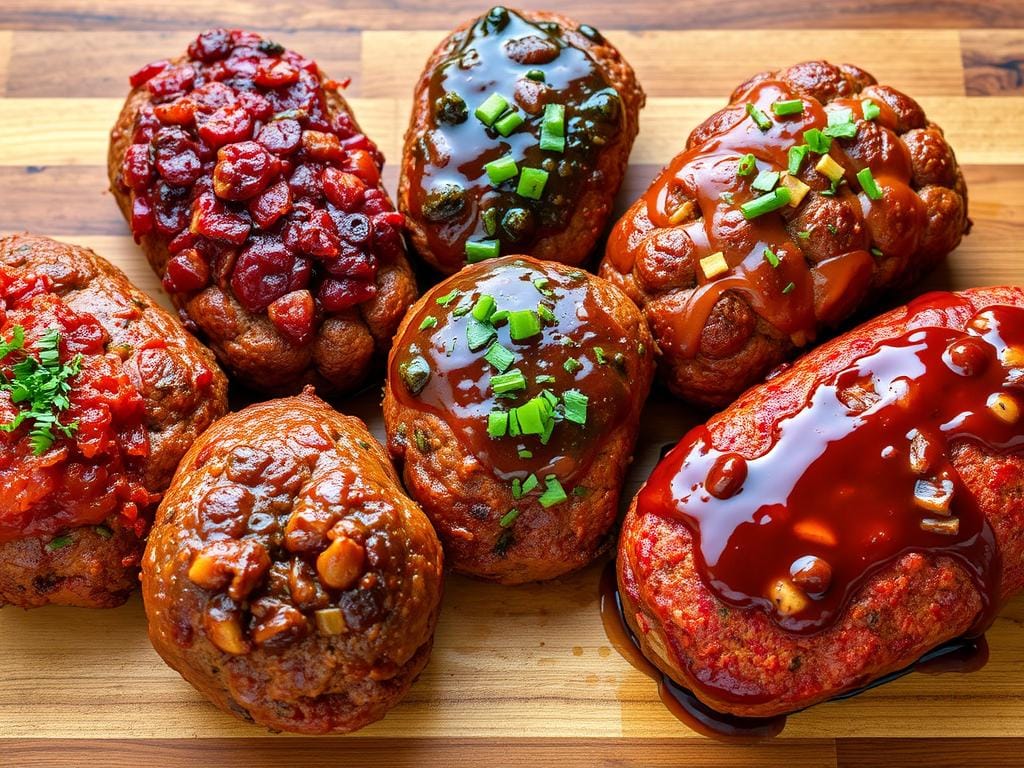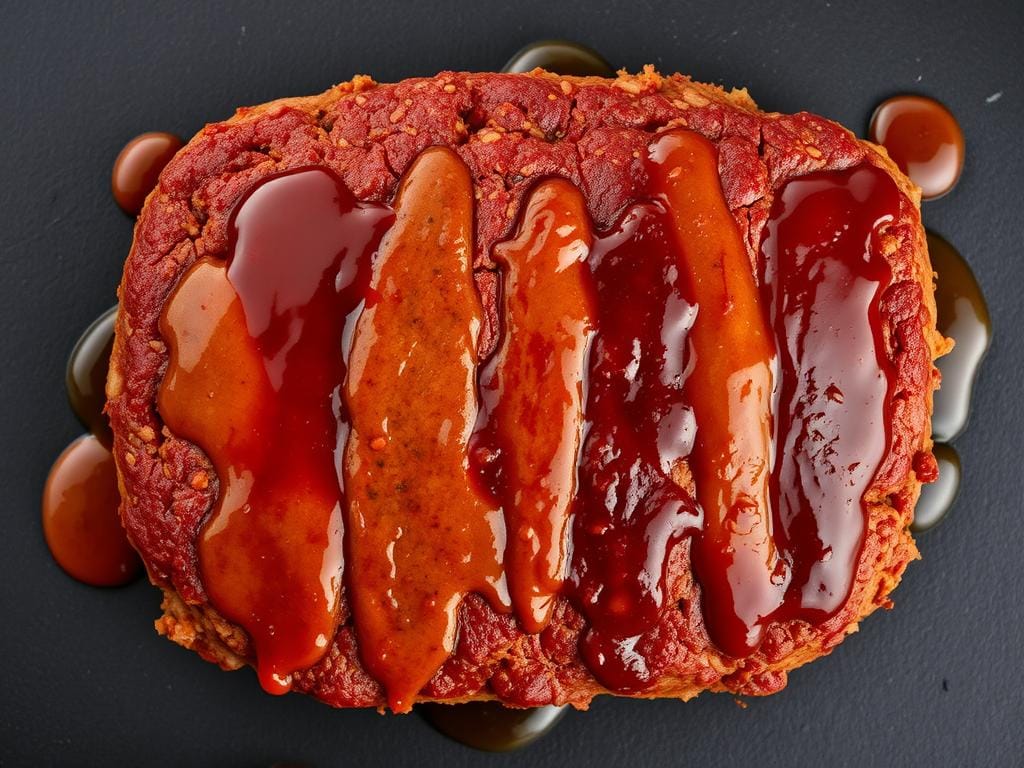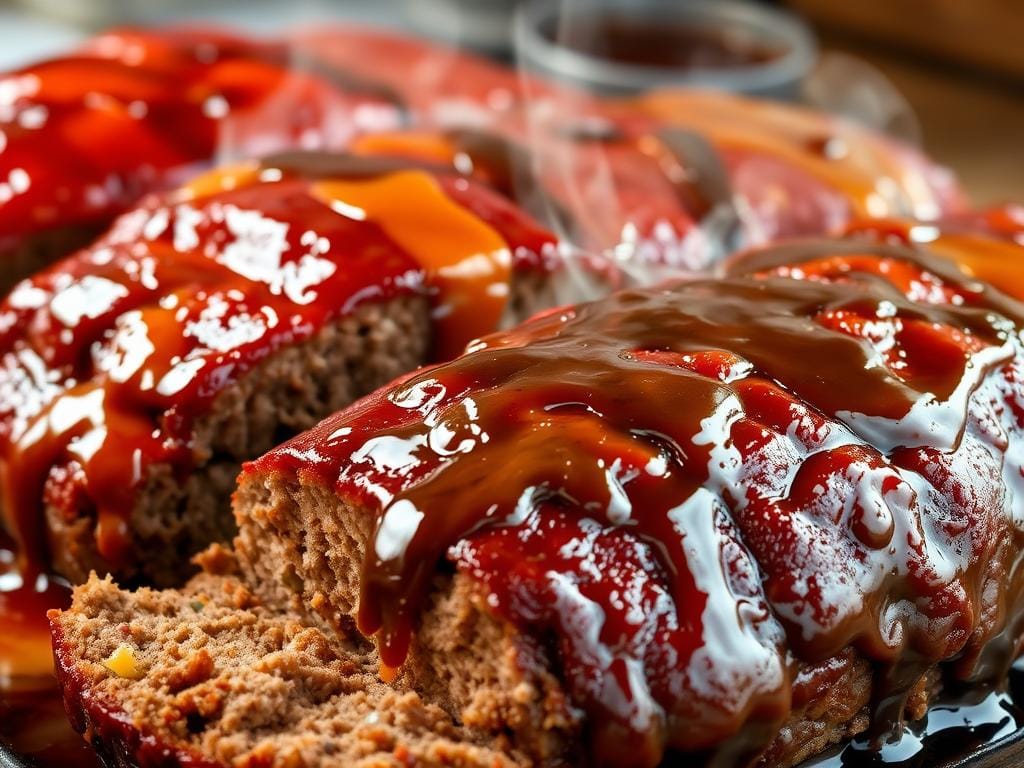Every Sunday, our kitchen would fill with the smell of my grandmother’s meatloaf. It was more than just a meal; it was a family tradition. The secret was the magical sauce that made it special.
Finding the right Sauces for meatloaf can turn a simple dinner into a feast. Whether you’re cooking at home or love to experiment in the kitchen, the right sauce can make a big difference.
In American kitchens, meatloaf is a beloved comfort food. With so many sauce options, you can make your meatloaf unique and delicious for everyone.
Key Takeaways
- Sauces dramatically transform meatloaf flavor profiles
- Tomato-based glazes remain most popular
- Sweet and tangy combinations work best
- Homemade sauces offer more customization
- Proper glaze application ensures maximum taste
Why the Right Sauce Can Transform Your Meatloaf

Making the perfect meatloaf topping is an art. It can turn a simple dish into something amazing. The right sauce does more than add flavor. It changes how you enjoy the meal.
Your meatloaf topping recipe is key to a great meal. A good sauce does several important things:
- Adds moisture to keep it from drying out
- Brings in deep flavors
- Makes the outside crispy and caramelized
- Helps the ingredients stick together
Choosing the right meatloaf topping recipe is about knowing how ingredients work together. Acidic components like ketchup or vinegar make the meat tender. Sweet things like brown sugar give it a shiny finish.
Did you know a meatloaf glaze has about 21 calories per serving? Here’s what it’s made of:
- Carbohydrates: 5g
- Sugar: 5g
- Sodium: 97mg
- Protein: 0.1g
Pro tip: Put your meatloaf topping on about 25 minutes into baking. Let it cook for 20-35 more minutes to get that perfect glaze. Make sure the inside is 165ºF for safety.
5 Must-Try Meatloaf Glazes
Want to make your meatloaf stand out? The right glaze can do it. These five glaze recipes will take your dish from good to amazing. Each one adds a special flavor that makes your meal unforgettable.
Classic Ketchup Glaze for Meatloaf
The classic ketchup glaze is a favorite for many. Mix 1/2 cup ketchup, 2 tablespoons brown sugar, and 1 tablespoon white vinegar. This sweet and tangy topping is perfect for the meat’s rich flavor.
BBQ Honey Glaze
Try a BBQ honey glaze for a smoky-sweet taste. Mix 1/4 cup BBQ sauce with 2 tablespoons honey. This glaze caramelizes beautifully and adds depth to your meatloaf.
Mustard-Brown Sugar Glaze
For a bold twist, try a mustard-brown sugar glaze. It’s a zesty alternative to usual sauces. Mix 1/4 cup yellow mustard with 3 tablespoons brown sugar for a flavor boost.
Spicy Sriracha Glaze
Love a little heat? This spicy glaze is perfect. Mix 1/4 cup ketchup, 2 tablespoons Sriracha sauce, and 1 tablespoon honey. It adds a spicy kick to your meatloaf.
| Glaze Type | Key Ingredients | Flavor Profile |
|---|---|---|
| Classic Ketchup | Ketchup, Brown Sugar, Vinegar | Sweet and Tangy |
| BBQ Honey | BBQ Sauce, Honey | Smoky and Sweet |
| Mustard-Brown Sugar | Yellow Mustard, Brown Sugar | Tangy and Bold |
| Spicy Sriracha | Ketchup, Sriracha, Honey | Spicy and Sweet |

Pro tip: Apply these glazes in the last 20 minutes of baking. This prevents burning and gives a perfect caramelized finish. Your meatloaf will look and taste amazing.
How to Apply Glaze for the Best Results
Learning to apply sauce to meatloaf can turn a simple dish into a work of art. The secret to a great meatloaf topping is in how you glaze it. This technique boosts both taste and looks.
- Initial Preparation: Begin with a thin glaze layer before baking. This first coat locks in moisture and sets the flavor base.
- Timing is Critical: Add more glaze during the last 15-20 minutes of cooking. This prevents burning and adds a deep, caramelized crust.
- Temperature Control: Keep your oven at 350°F for the best glazing results.
Your meatloaf topping should mix sweet and tangy flavors. A classic glaze usually has:
- ¾ cup ketchup
- 2 tablespoons brown sugar
- 1 tablespoon apple cider vinegar
- Pinch of garlic powder
Here are some tips for glazing like a pro:
- Brush the glaze lightly to avoid damaging the meatloaf’s surface.
- Use a silicone brush for smooth, even coverage.
- Make sure the meatloaf’s internal temperature hits 160°F for safety.
After glazing, let your meatloaf rest for 10 minutes. This lets the sauce set and prevents it from falling off when you slice it.
FAQs About Sauces for meatloaf Toppings
Creating the perfect meatloaf glaze can be tricky. Many home cooks have questions about getting that ideal topping. A classic ketchup glaze for meatloaf is often the go-to choice. But understanding how to apply and perfect your sauce makes all the difference.
When applying a meatloaf glaze, timing is key. Experts say to add the glaze during the last 20-30 minutes of cooking to prevent burning. Your meatloaf glaze should be applied when the internal temperature reaches around 140°F. This allows it to caramelize without scorching.
For those using a ketchup glaze for meatloaf, mix in some brown sugar. This enhances both flavor and shine. To ensure your glaze sticks perfectly, pat the meatloaf surface dry before applying. Thin glazes work best, as they spread evenly and create a beautiful, glossy finish.
If you’re worried about burning, cover the meatloaf loosely with foil after glazing. Remember that different sauces require different application techniques. Some work better brushed on, while others can be poured directly over the top.
Dietary restrictions don’t mean sacrificing flavor. You can easily substitute ingredients in your meatloaf glaze. For those watching sugar intake, try using sugar-free ketchup or a low-sugar alternative. Gluten-free home cooks can swap traditional ingredients with gluten-free versions without compromising taste.
The key is experimenting and finding the perfect glaze. It should suit your personal preferences and nutritional needs.
FAQ
Q: How can I prevent my meatloaf glaze from burning?
A: To avoid burning, glaze your meatloaf in the last 15-20 minutes of cooking. If the glaze browns too fast, cover it with foil. Use a lower oven temperature, around 350°F, for even caramelization.
Q: Can I make a glaze ahead of time?
A: Yes, you can! Most glazes can be made ahead and stored in an airtight container in the fridge for up to a week. This lets the flavors mix and makes prep easier.
Q: How do I get my glaze to stick to the meatloaf?
A: Make sure the meatloaf is dry before glazing. Pat it dry with paper towels and apply the glaze in thin layers. Brush it on several times during the last 15-20 minutes for better stickiness and flavor.
Q: Are there low-sugar alternatives for meatloaf glazes?
A: Yes! Use sugar substitutes like monk fruit sweetener. Or make a glaze with sugar-free ketchup and maple syrup. You can also use sugar-free BBQ sauce or a glaze made from roasted red peppers and herbs.
Q: How much glaze should I use on my meatloaf?
A: For a 2-pound meatloaf, use about 1/4 to 1/3 cup of glaze. Apply thin layers to prevent burning and ensure even coverage.
Q: Can I freeze meatloaf with glaze?
A: It’s best to freeze the meatloaf without glaze. Cool it, then wrap it tightly in plastic wrap and foil. Thaw it in the fridge and add fresh glaze before reheating.
Q: What can I do if my glaze is too thick?
A: To thin a thick glaze, add a little water, vinegar, or broth. Mix slowly until it’s right. For a thinner glaze, add liquid a teaspoon at a time to avoid it getting too runny.
Q: Are there gluten-free glaze options?
A: Yes, many glazes can be gluten-free. Use gluten-free ketchup, tamari instead of soy sauce, and ensure all ingredients are gluten-free. Always check labels.

